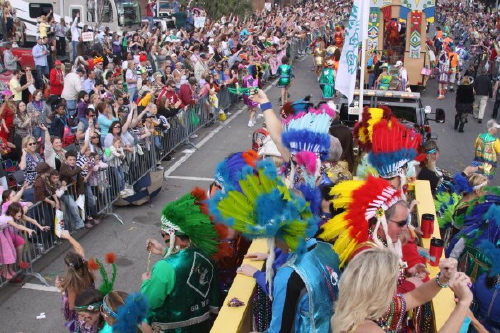.gif)

.gif) |
|
|---|
2010's
|
2010's |
|
From the Facebook page of the "tribe": "The Mayoki Indians are a fictitious tribe that was formed over 40 years ago to enhance the City of Pensacola's annual Fiesta of Five Flags celebration. During the Fiesta season, the Mayoki Court takes part in a light-hearted parody of what might have happened when Spanish Conquistador Don Tristan Deluna first landed on the shores of Pensacola Beach in 1559." [WHY?! (credit/thanks to a student)] |
 
|
|
More "Indian Hotty"/Holiday hilarity (or inanity). HalloweenCostumes.com offers costumes like these pictured on the right with such alluring ad copy as "Be the sexiest squaw in the tribe this Halloween!" and "This sexy Indian squaw costume will get attention on Halloween!" The 2nd photo is specifically supposed to be Pocahontas—in stiletto boots: "This Indian princess will make all of the pilgrims fall in love with the New World!" (Native ecofeminists have much food for thought here.) [Credit/thanks to a student.] |


|
|
This drive-in theatre—in Topeka, Kansas—has been out of business since the 1980's; but the marquee remains in use, having been purchased by—Wal-Mart! According to RoadsideAmerica.com, "[T]he sign is a visual reminder of how creative and colorful outdoor advertising and signage once was." Hmmm. [Photo, and clever exhibit title, by student.]  |
||
I drove through northern Arizona and New Mexico this summer [2010], and it occurred to me that any 4th-grader seeing the roadside tourist Indian kitsch would assume that the local Natives (e.g., the Diné & Pueblo) live/lived in tipis. The proclaimed-on-roadsigns-for fifty-miles Geronimo Trading Post (1st picture) is an emblematic demonstration of that: "Yes, little Johnny, the Mescalero Apaches lived in tipis, too." Almost worse is the postcard below, and its typical whitestream conflation/confusion of tipi and wigwam. The small print on the "Wigwam Motel" sign asks, "Have You Slept in a Wigwam Lately?" Well, you won't here, either, even metaphorically: those are (faux) "tipis" in the picture—again, THE traditional abode of the Natives of the desert Southwest. (Not.) |


|
|
(Speaking of Geronimo . . . .) This is getting old. It's 2011, but Indians still = terrorists. Worse yet, the code name was apparently blithely used by an African-American President with nary an eye blink. |

|
|
Here in Lincoln, NE, I just found out that there's an RV sales lot called Apache Camper Center—which got me thinking about the various "Indian" names for vehicles, names suggestive of a hunter-gatherer mobility and explicitly connotative of a "native" ability to skillfully encounter the "wild." This marketing discourse goes back at least to the Indian motorcycle (1901-1953); has continued with the Pontiac (1926-2010), the Dodge Dakota (1986-), the Mazda Navajo (1991-1994), and the Pontiac Aztek (2001-2005; double-kill of a name!); and is perhaps most famously epitomized by the Jeep Cherokee (1974-) [pictured (& photoshopped); I won't even ask why the desert Southwest is appropriate for a—Cherokee]. (There was also a pickup-truck version, the Jeep Comanche [1986-1992].) * "How might one think about the uncertainties conjured up, for instance, when the non-Indian world turns to imagine a Cherokee in a Cherokee—or a Geronimo in a Cadillac?" —Philip J. Deloria, Indians in Unexpected Places (2004) * "Tallulah imagines an Oklahoma Cherokee man driving a big red Jeep Cherokee with multiple American-flag bumper stickers, driving to Kansas City to watch a Chiefs-Redskins game, listening to the song 'Indian Outlaw' on repeat, and howling along the with lyrics as he swerves between highway lanes, absolutely loving every minute of it." —Blake M. Hausman, Riding the Trail of Tears (2011) |

|
|
The photo-scan on the right is part of a 2011 magazine spread for the KIA Optima that claims, "This ancient chief could have asked the gods for absolutely anything. As you can see, he chose the all new 2011 Kia Optima . . . it makes perfect sense." Absurd, inane . . . Blogger Blogger Cristina Burgos pointedly asks, "What in the world does a KIA Optima have to do with Hispanic indigenous culture?" Her brilliant critique is better than anything I coould especially, especially regarding KIA's intended Latina/o audience here, so I'll just point you to Monday morning boo: KIA que tontería. |

|
|
My first impulse was to simply exclaim, "Jesus Messed-Up Christ—still, in this day & age?" But a quick web search indicates that "squaw bread" is indeed a traditional (Euro-American) recipe, and its name probably raised nary an eyebrow a century or so ago. My next thought, then, was that only a company on the east or west coast might be blind to the cultural insult? Sure enough, Milton's Craft Bakers is located in San Diego, CA. This bread is described as follows: "Some people take one look at our all natural Squaw Bread and think its [sic] pumpernickel. But this dark and hearty bread has a surprisingly sweet flavor thanks to a hint of honey." (I'll refrain from discussing any possible unintended double entendres.) |

|
|